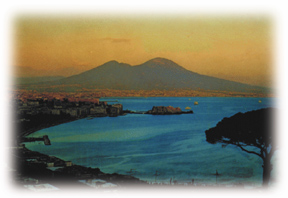 Now, some Italian
and French researchers say that a massive magma layer beneath Mount Vesuvius
may hold the key to understanding the historic volcano’s past and future. Reporting
in the Nov. 16 Science, Emmanuel Auger and colleagues used seismic data
to locate a magma reservoir 400 square kilometers wide that sits 8 kilometers
below Mount Vesuvius.
Now, some Italian
and French researchers say that a massive magma layer beneath Mount Vesuvius
may hold the key to understanding the historic volcano’s past and future. Reporting
in the Nov. 16 Science, Emmanuel Auger and colleagues used seismic data
to locate a magma reservoir 400 square kilometers wide that sits 8 kilometers
below Mount Vesuvius. [ At right, Mount Vesuvius as seen from the city of Naples, Italy. Mt Vesuvius is perhaps best known for burying the Roman towns of Pompeii and Herculaneum with hot lava flows and debris in A.D. 79. The volcano also erupted in 472 and 1631. More frequent, less explosive eruptions occurred between 1631 and 1944. Courtesy of Paul Gasparini.]
Researchers were surprised to find such a large amount of magma under Vesuvius, says Auger, a researcher at the Università di Napoli Federico II in Naples. “We believe it is a regional item and that it is probably present beneath the nearby Phlegrean Fields volcano. No estimation of the magma layer’s extent had been made before.”
Locating the reservoir does not help scientists predict the volcano’s next eruption, but it does identify areas that could provide seismic clues. “If deep seismic events were detected at 6 to 8 kilometers, it might mean that magma is rising,” Auger says. By creating a clearer picture of the way the magma below Mount Vesuvius interacts with the crust, researchers can better understand the volcano’s pattern of expected activity and ground deformation.
Using seismic tomography, Auger’s team probed beneath Mount Vesuvius, gaining glimpses of the crust’s structure. They created explosions to generate seismic waves, followed the waves’ movements through the crust and then gathered data on the speed and direction of the waves arriving at 25 stations. To create the explosions, Auger’s team used 1,800 shots from 16-liter air guns on a ship in the Bay of Naples.
The team estimated S-wave velocities between 0.6 and 1 kilometer per second and P-wave velocities of approximately 2 kilometers per second. “I think the most important finding is the quantitative estimation of the S wave velocity in the low velocity layer: the very low value is a very strong indication of the presence of a semi-molten material. We can now say it is magma,” Auger says.
Past research hinted at the existence of such a magma reservoir. In 1994, Aldo Zollo and others detected an area of low seismic wave velocity within the crust below Mount Vesuvius. Seismic waves travel slower through a liquid than a solid, and wave changes most often occur at a boundary between two different geologic layers. Therefore, the conversion and slowing down of the waves implied the possible presence of a deep melting zone.
This latest research strengthens those past results and adds a new layer to the model of Mount Vesuvius’ magma feeding system, Auger says. “The scenario for the Vesuvius magma feeding system now has two magma reservoirs on which all geologists agree: a large, deep one, the magma layer; and a shallower, smaller one,” Auger says. The tomographic images indicate that the magma lies flat and parallel to the crust’s layers. Denser and more buoyant than the surrounding rock, the magma rises toward the crust and reaches neutral buoyancy with the rock, floating in a trapped layer.
Auger says that isotopic studies of the material ejected during the strongest eruptions also support their model. Isotopic ratios in Neapolitan volcanic magma show signs of significant mixing with the surrounding rock, suggesting the reservoir might look more like a sponge, with the magma seeping through fractures in the rock. The magma has a two-fold origin, Auger says, where the 400-square-kilometer magma layer feeds into several smaller layers closer to the surface.
Another volcanologist, Tobias Fischer of the University of New Mexico, says that the resolution of the study does not elucidate whether the magma is completely molten or partially molten. Still, Fischer adds, a partially molten body of magma in a dendritic fracture system of rock seems to be a plausible interpretation of what is happening below Vesuvius. He adds that Auger’s observations are consistent with and supportive of the idea that magma below Vesuvius remains at mid-crustal levels for a long time and interacts with the crust.
“In terms of forecasting a future eruption, I do not think that the findings can be directly used to forecast the next eruption. The findings, however, are critical for the interpretation of seismicity and gas emission data that may lead up to the next eruption because they constrain the depth and extent of the magma body below the volcano,” Fischer says.

